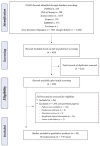Clinical and radiographic characteristics of pycnodysostosis: A systematic review
- PMID: 38571780
- PMCID: PMC10985529
- DOI: 10.5624/isd.20230191
Clinical and radiographic characteristics of pycnodysostosis: A systematic review
Abstract
Purpose: Pycnodysostosis (PYCD), an autosomal recessive syndrome, is characterized by an imbalance in bone remodeling that produces various clinical and radiographic craniofacial manifestations. This review represents a systematic examination of these manifestations, as well as oral features associated with PYCD.
Materials and methods: A systematic review was conducted across 8 databases from February to March 2023. The search strategy focused on studies reporting cases of PYCD that examined the clinical and radiographic craniofacial and oral characteristics associated with this syndrome.
Results: The review included 84 studies, encompassing a total of 179 cases of PYCD. More than half of the patients were female (55.3%), and the mean age was 14.7 years. Parental consanguinity was reported in 51.4% of the cases. The most common craniofacial clinical manifestation was a prominent nose, observed in 57.5% of cases. Radiographically, the most frequently reported craniofacial characteristics included the presence of an obtuse mandibular angle (84.3%) and frontal cranial bosses (82.1%). Clinical and radiographic examinations revealed oral alterations, with micrognathia present in 62.6% of patients and malocclusion in 59.2%. Among dental anomalies, tooth agenesis was the most commonly reported, affecting 15.6% of patients.
Conclusion: Understanding the clinical and radiographic craniofacial features of PYCD is crucial for dental professionals. This knowledge enables these clinicians to devise effective treatment plans and improve patient quality of life.
Keywords: Diagnostic Imaging; Maxillofacial Abnormalities; Pycnodysostosis; Syndrome.
Copyright © 2024 by Korean Academy of Oral and Maxillofacial Radiology.
Conflict of interest statement
Conflicts of Interest: None
Figures





References
-
- Andren L, Dymling JF, Hogeman KE, Wendeberg B. Osteopetrosis acro-osteolytica. A syndrome of osteopetrosis, acro-osteolysis and open sutures of the skull. Acta Chir Scand. 1962;124:496–507. - PubMed
-
- Lamy M, Maroteaux P. Pycnodysostosis. Rev Esp Pediatr. 1965;21:433–437. - PubMed
-
- Sait H, Srivastava P, Gupta N, Kabra M, Kapoor S, Ranganath P, et al. Phenotypic and genotypic spectrum of CTSK variants in a cohort of twenty-five Indian patients with pycnodysostosis. Eur J Med Genet. 2021;64:104235. - PubMed
-
- Moreira LC, Jr, França GM, Santos VD, Galvão HC, Gomes PP, Germano AR. Update of dental and maxillofacial alterations in patients with pycnodysostosis. J Bras Patol Med Lab. 2019;55:506–515.

